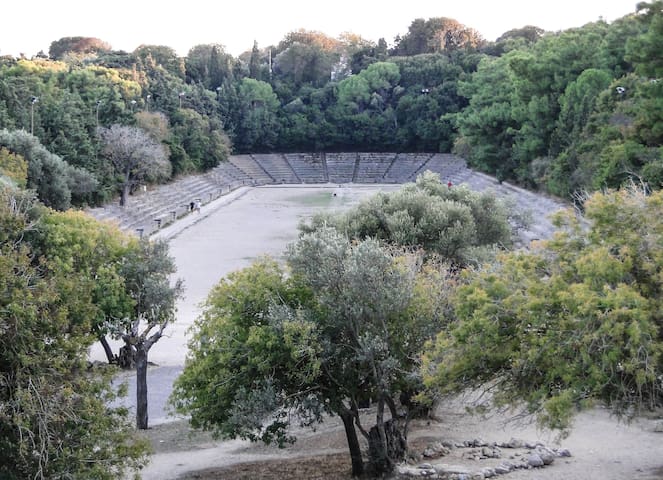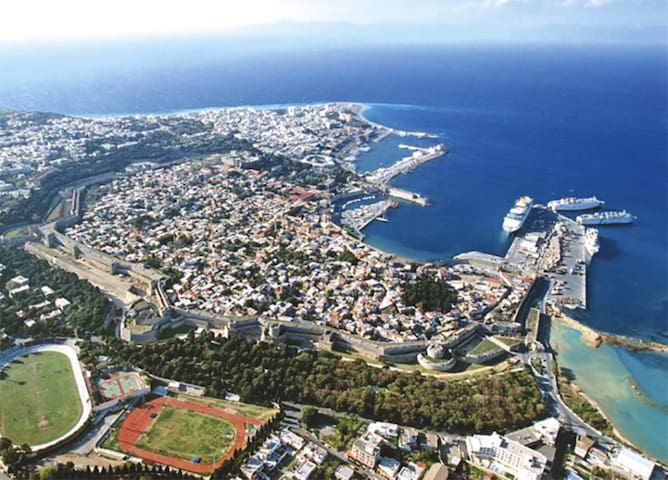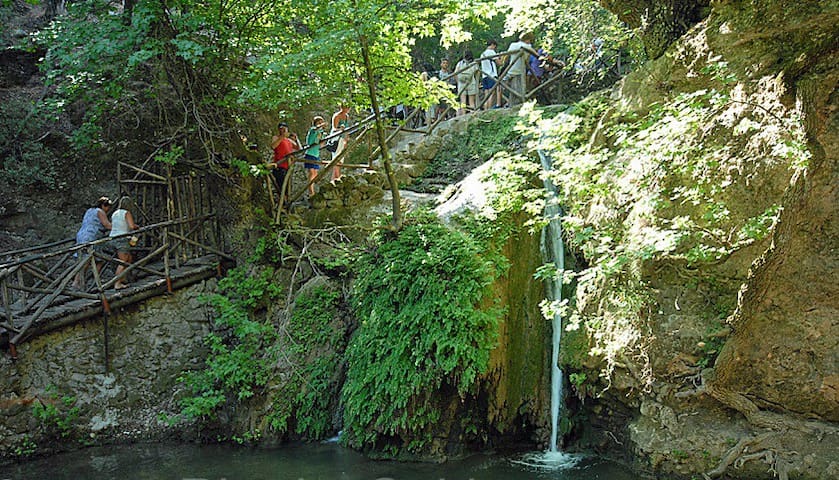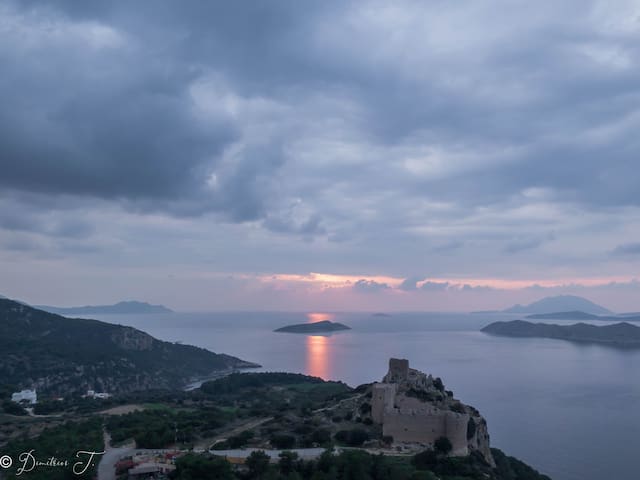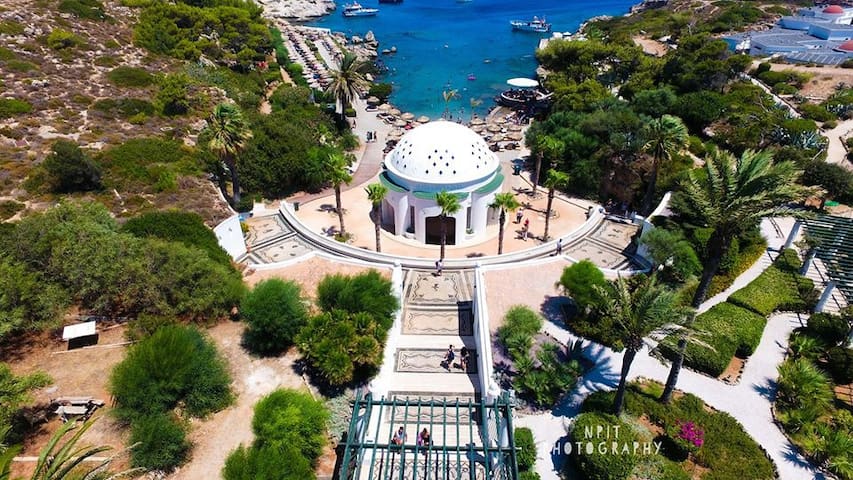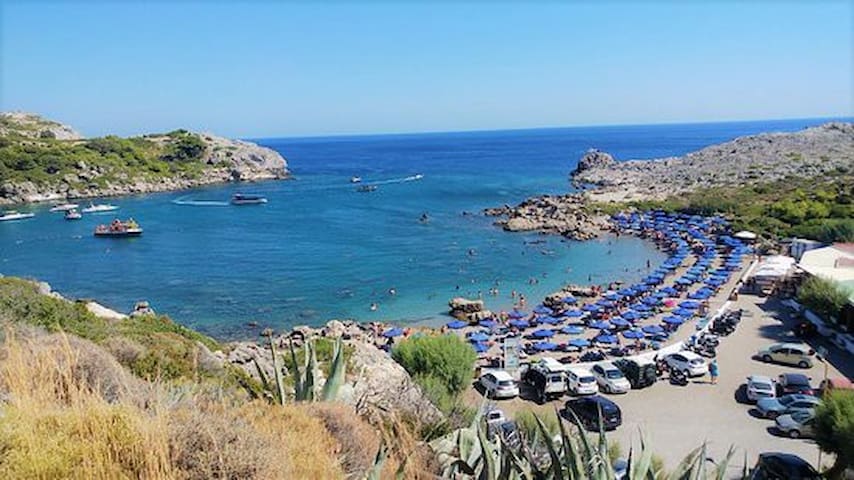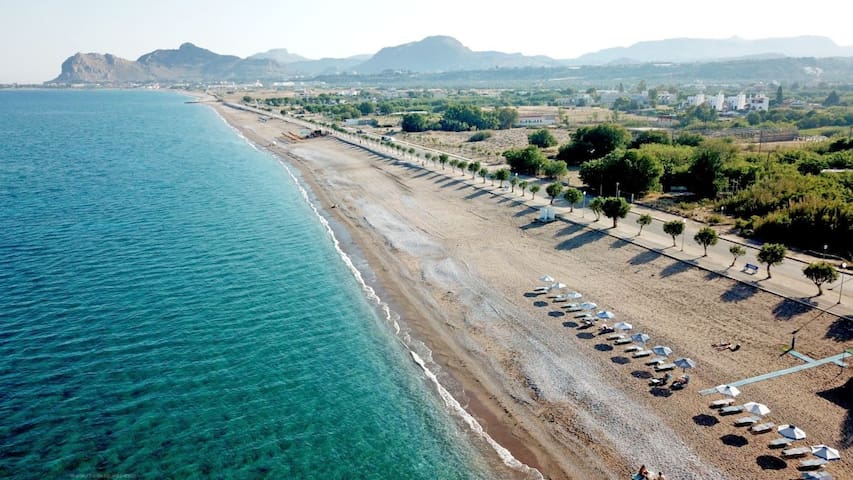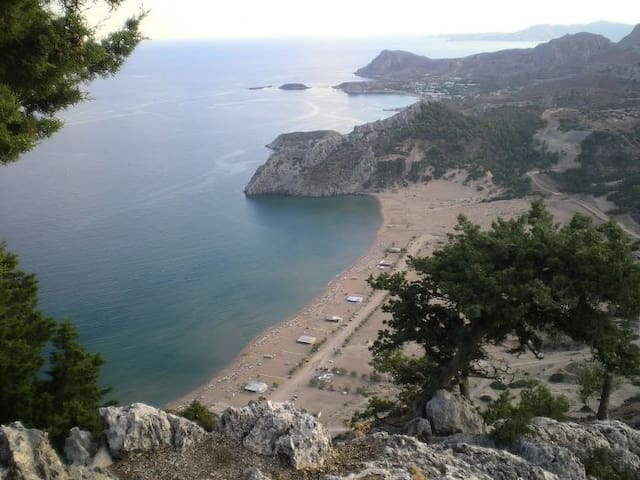City/town information
Rhodes, Greek: Ρόδος, is the largest of the 12 Dodecanese islands of Greece and is also the island group's historical capital. Administratively the island forms a separate municipality within the Rhodes regional unit, which is part of the South Aegean administrative region. The principal town of the island and seat of the municipality is Rhodes. The city of Rhodes had 50,636 inhabitants in 2011. It is located northeast of Crete, southeast of Athens. Rhodes' nickname is The Island of the Knights, named after the Knights of Saint John of Jerusalem, who ruled the island from 1310 to 1522.
Historically, Rhodes island was very famous worldwide for the Colossus of Rhodes, one of the Seven Wonders of the Ancient World. The Medieval Old Town of the City of Rhodes has been declared a World Heritage Site. The island of Rhodes is shaped like a spearhead, 79.7 km (49.5 mi) long and 38 km (24 mi) wide, with a total area of approximately 1,400 square kilometres (541 sq mi) and a coastline of approximately 220 km (137 mi)The city of Rhodes is located at the northern tip of the island, as well as the site of the ancient and modern commercial harbours. The main airport is(the Diagoras International Airport, IATA code: RHO) located 14 km (9 mi) to the southwest of the city in Paradisi. The road network radiates from the city along the east and west coasts.Outside the city of Rhodes, the island is dotted with small villages of white-wash homes and spa resorts,among them at the west coast Ialysos-Filerimos- Acropolis, Paradisi-Butterflies Valley, Ancient Kamiros,Embona, Kritinia-Castel, Monolithos-Castel and at the east coast Kalithea-beach, Faliraki-beach, Afandou-golf-beach, Seven springs, Kolymbia-beach, Archagelos-Tsambika beach, Malona- Haraki beach, Lindos-Acropolis-beach,Pefki-beach, Kiotari-beach, Gennadi-beach,Prasonisi cape -the end of the island.
45 recommandé par les habitants
Rhodes
Rhodes, Greek: Ρόδος, is the largest of the 12 Dodecanese islands of Greece and is also the island group's historical capital. Administratively the island forms a separate municipality within the Rhodes regional unit, which is part of the South Aegean administrative region. The principal town of the island and seat of the municipality is Rhodes. The city of Rhodes had 50,636 inhabitants in 2011. It is located northeast of Crete, southeast of Athens. Rhodes' nickname is The Island of the Knights, named after the Knights of Saint John of Jerusalem, who ruled the island from 1310 to 1522.
Historically, Rhodes island was very famous worldwide for the Colossus of Rhodes, one of the Seven Wonders of the Ancient World. The Medieval Old Town of the City of Rhodes has been declared a World Heritage Site. The island of Rhodes is shaped like a spearhead, 79.7 km (49.5 mi) long and 38 km (24 mi) wide, with a total area of approximately 1,400 square kilometres (541 sq mi) and a coastline of approximately 220 km (137 mi)The city of Rhodes is located at the northern tip of the island, as well as the site of the ancient and modern commercial harbours. The main airport is(the Diagoras International Airport, IATA code: RHO) located 14 km (9 mi) to the southwest of the city in Paradisi. The road network radiates from the city along the east and west coasts.Outside the city of Rhodes, the island is dotted with small villages of white-wash homes and spa resorts,among them at the west coast Ialysos-Filerimos- Acropolis, Paradisi-Butterflies Valley, Ancient Kamiros,Embona, Kritinia-Castel, Monolithos-Castel and at the east coast Kalithea-beach, Faliraki-beach, Afandou-golf-beach, Seven springs, Kolymbia-beach, Archagelos-Tsambika beach, Malona- Haraki beach, Lindos-Acropolis-beach,Pefki-beach, Kiotari-beach, Gennadi-beach,Prasonisi cape -the end of the island.
Αξιοθέατα
The Marine Aquarium in Rhodes is located in the basement of the Hydrobiological station and offers visitors the chance to have a close up view of the marine life of the Eastern Mediterranean, providing the impression of being underwater.The Hydrobiological Station (Marine Aquarium) of Rhodes is located in the northern part of the island and was constructed during 1934-1936, initiating its activities in 1937. In 1945 it was incorporated as a peripheral station of the Greek Hydrobiological Institute under the supervision of the Athens Academy. It has been operating as an Aquarium and museum and research unit since 1963. It belongs to the National Centre for Marine Research (NCMR) which is developing its research activities in oceanography, fisheries and inland waters corresponding institutes.
Opening Hours and Admission fee please take a look at the attached "Time Schedule of Archaeological Sites"
51 recommandé par les habitants
Aquarium de Rhodes
The Marine Aquarium in Rhodes is located in the basement of the Hydrobiological station and offers visitors the chance to have a close up view of the marine life of the Eastern Mediterranean, providing the impression of being underwater.The Hydrobiological Station (Marine Aquarium) of Rhodes is located in the northern part of the island and was constructed during 1934-1936, initiating its activities in 1937. In 1945 it was incorporated as a peripheral station of the Greek Hydrobiological Institute under the supervision of the Athens Academy. It has been operating as an Aquarium and museum and research unit since 1963. It belongs to the National Centre for Marine Research (NCMR) which is developing its research activities in oceanography, fisheries and inland waters corresponding institutes.
Opening Hours and Admission fee please take a look at the attached "Time Schedule of Archaeological Sites"
The Palace of the Grand Master of the Knights of Rhodes, also known as the Kastello, is a medieval castle in the city of Rhodes.According to recent study, in the exact spot in which the palace exists today, there was the foundations of the ancient temple of the Sun-God 'Helios' and probably that was the spot where Colossus of Rhodes stood in the Antiquity. The palace was originally built in the late 7th century as a Byzantine citadel. After the Knights Hospitaller occupied Rhodes and some other Greek islands in 1309, they converted the fortress into their administrative centre and the palace of their Grand Master. In the first quarter of the 14th century, they repaired the palace and made a number of major modifications. The palace was damaged in the earthquake of 1481, and it was repaired soon afterwards. After the 1522 capture of the island by the Ottoman Empire, the palace was used as a command centre and fortress.During the Italian rule of Rhodes, the Italian architect Vittorio Mesturino restored the damaged parts of the palace between 1937 and 1940. It became a holiday residence for the King of Italy, Victor Emmanuel III, and later for Fascist dictator Benito Mussolini, whose name can still be seen on a large plaque near the entrance.On 10 February 1947, the Treaty of Peace with Italy, one of the Paris Peace Treaties, determined that the recently established Italian Republic would transfer the Dodecanese Islands to Greece. In 1948, Rhodes and the rest of the Dodecanese were transferred as previously agreed. The palace was then converted to a museum, and is today visited by the millions of tourists that visit Rhodes. It is situated only few minutes from the city center.
Opening Hours and Admission fee please take a look at the attached "Time Schedule of Archaeological Sites
112 recommandé par les habitants
Palais du Grand Maître des Chevaliers de Rhodes
IppotonThe Palace of the Grand Master of the Knights of Rhodes, also known as the Kastello, is a medieval castle in the city of Rhodes.According to recent study, in the exact spot in which the palace exists today, there was the foundations of the ancient temple of the Sun-God 'Helios' and probably that was the spot where Colossus of Rhodes stood in the Antiquity. The palace was originally built in the late 7th century as a Byzantine citadel. After the Knights Hospitaller occupied Rhodes and some other Greek islands in 1309, they converted the fortress into their administrative centre and the palace of their Grand Master. In the first quarter of the 14th century, they repaired the palace and made a number of major modifications. The palace was damaged in the earthquake of 1481, and it was repaired soon afterwards. After the 1522 capture of the island by the Ottoman Empire, the palace was used as a command centre and fortress.During the Italian rule of Rhodes, the Italian architect Vittorio Mesturino restored the damaged parts of the palace between 1937 and 1940. It became a holiday residence for the King of Italy, Victor Emmanuel III, and later for Fascist dictator Benito Mussolini, whose name can still be seen on a large plaque near the entrance.On 10 February 1947, the Treaty of Peace with Italy, one of the Paris Peace Treaties, determined that the recently established Italian Republic would transfer the Dodecanese Islands to Greece. In 1948, Rhodes and the rest of the Dodecanese were transferred as previously agreed. The palace was then converted to a museum, and is today visited by the millions of tourists that visit Rhodes. It is situated only few minutes from the city center.
Opening Hours and Admission fee please take a look at the attached "Time Schedule of Archaeological Sites
Tha Archaeological Museum of Rhodes is located in the medieval city (old city) at the end of the Knights Street,housed in the building of the Grand Hospital of the Knights. The constuction of the building started in 1440 and it lasted 50 years. It operates as Archaeological Museum since 1914 and its rooms house finds from excavations in Rhodes and in other islands of Dodecanese.
It is easily accessible both on foot and bus as it is located near the main coastal road.Nearby there is a taxi station restaurants, bars, tourist shop and a bank.
Opening Hours and Admission fee please take a look at the attached "Time Schedule of Archaeological Sites
65 recommandé par les habitants
Musée archéologique de Rhodes (Hôpital des Chevaliers)
8 Akti SachtouriTha Archaeological Museum of Rhodes is located in the medieval city (old city) at the end of the Knights Street,housed in the building of the Grand Hospital of the Knights. The constuction of the building started in 1440 and it lasted 50 years. It operates as Archaeological Museum since 1914 and its rooms house finds from excavations in Rhodes and in other islands of Dodecanese.
It is easily accessible both on foot and bus as it is located near the main coastal road.Nearby there is a taxi station restaurants, bars, tourist shop and a bank.
Opening Hours and Admission fee please take a look at the attached "Time Schedule of Archaeological Sites
The Acropolis stood on the hill now known as Monte Smith. The green and beautifully laid out archaeological park contains the Hellenistic stadium, built in the 3rd century BC, where the athletic events of the Alioi Games took place. These were a part of the major festival of the ancient Rhodians held in honour of the sun-god Helios.
Next to the stadium is the small restored Roman Odeon. Just as in ancient times, events are still staged here today. Along Isiodou St. are the remains of the temple of Athena Polias and Zeus Polieus, at the northernmost point of the hill.
On the summit of the Acropolis stands the temple of Pythion Apollo, the patron deity of the city. From here there is a panoramic view of the city and the sea. The sunsets are breathtaking.
Opening Hours and Admission fee please take a look at the attached "Time Schedule of Archaeological Sites
65 recommandé par les habitants
Acropolis of Rhodes
68 DiagoridonThe Acropolis stood on the hill now known as Monte Smith. The green and beautifully laid out archaeological park contains the Hellenistic stadium, built in the 3rd century BC, where the athletic events of the Alioi Games took place. These were a part of the major festival of the ancient Rhodians held in honour of the sun-god Helios.
Next to the stadium is the small restored Roman Odeon. Just as in ancient times, events are still staged here today. Along Isiodou St. are the remains of the temple of Athena Polias and Zeus Polieus, at the northernmost point of the hill.
On the summit of the Acropolis stands the temple of Pythion Apollo, the patron deity of the city. From here there is a panoramic view of the city and the sea. The sunsets are breathtaking.
Opening Hours and Admission fee please take a look at the attached "Time Schedule of Archaeological Sites
Old Town. In the heart of Rhodes, in the medieval city, a haunting and mysterious air wafts through the streets, summoned back to life through the centuries. The famous Order of the Knights of Saint John of Jerusalem, the Hospitallers, has left an indelible mark on the island. If one walks around the always lively town, one can almost hear the hoofbeats of the horses and the whispering voices of history.
The town was never deserted or abandoned. It is one of the rare survivors of the medieval world; it stands unscathed, in all its vibrant beauty. In 1988, UNESCO declared the architectural complex of the Knights of Rhodes to be World Heritage Site.
The feeling of exploring the medieval streets of Rhodes is difficult to put into words. Time seems to have stopped in the middle ages, and the atmosphere is shrouded in the haze of its knightly past. The cobbled streets and Gothic towers challenge the traveller to unlock their deepest secrets.
8 recommandé par les habitants
Rhodos Altstadt
Old Town. In the heart of Rhodes, in the medieval city, a haunting and mysterious air wafts through the streets, summoned back to life through the centuries. The famous Order of the Knights of Saint John of Jerusalem, the Hospitallers, has left an indelible mark on the island. If one walks around the always lively town, one can almost hear the hoofbeats of the horses and the whispering voices of history.
The town was never deserted or abandoned. It is one of the rare survivors of the medieval world; it stands unscathed, in all its vibrant beauty. In 1988, UNESCO declared the architectural complex of the Knights of Rhodes to be World Heritage Site.
The feeling of exploring the medieval streets of Rhodes is difficult to put into words. Time seems to have stopped in the middle ages, and the atmosphere is shrouded in the haze of its knightly past. The cobbled streets and Gothic towers challenge the traveller to unlock their deepest secrets.
Rodini Park of Rhodes: The impeccably landscaped Rodini Park is renowned for its cool and tranquil atmosphere. This beautiful park is ideally located just outskirts of the town. It is a mere 3 km away from the city center of Rhodes. The park is replete with trees like cypress and pine. There is also a swift-flowing stream in close proximity to the park. If there are children accompanying you, there is an exclusive playground for the young ones as well as a mini zoo. The Rodini Park has the unique distinction of being the world's first landscaped park. This park was very popular with the Romans and they even built an aqueduct here. Inside the park's premises, there are peacocks galore that are residents of the park. There is a well-defined walkway that extends all the way to the stream.
For the energetic ones, a 10 minutes walk is all it takes to be face to face with an ancient tomb which is believed to be the tomb of Ptolemies which has been dug into the rock. The tomb dates back to the Hellenistic period and is conspicuous by 21 half columns that are distinctly Doric in terms of architecture.
Daily Free entrance
53 recommandé par les habitants
Parc Rodini
LindouRodini Park of Rhodes: The impeccably landscaped Rodini Park is renowned for its cool and tranquil atmosphere. This beautiful park is ideally located just outskirts of the town. It is a mere 3 km away from the city center of Rhodes. The park is replete with trees like cypress and pine. There is also a swift-flowing stream in close proximity to the park. If there are children accompanying you, there is an exclusive playground for the young ones as well as a mini zoo. The Rodini Park has the unique distinction of being the world's first landscaped park. This park was very popular with the Romans and they even built an aqueduct here. Inside the park's premises, there are peacocks galore that are residents of the park. There is a well-defined walkway that extends all the way to the stream.
For the energetic ones, a 10 minutes walk is all it takes to be face to face with an ancient tomb which is believed to be the tomb of Ptolemies which has been dug into the rock. The tomb dates back to the Hellenistic period and is conspicuous by 21 half columns that are distinctly Doric in terms of architecture.
Daily Free entrance
Filerimos Hill is the site of the ancient acropolis of Ialyssos with its temple of Athena Polias. In Byzantine times, the hill was used as a fortress and in the 13th century the monastery of the Virgin Mary was built here.
During the period of the Knights the monastery, occupied by catholic monks, was extended and became justly celebrated. The Knights of Saint John came from noble European families and, despite their military prowess remained essentially monks, taking vows of celibacy, poverty and fidelity.
Today one can visit the ruins of the ancient acropolis and the monastery, as restored by the Italians. To the right of the archeological site is the beginning of the Calvary Way "Road of Golgotha" – another creation of the Italians. Here you will find Catholicism in all its splendour: shrines with relieve representations of the Passion and cypress trees to the left and right of the path. At the end of the path stands a large stone monument in the form of a cross, with windows and balconies. You can climb up and admire the view.
Opening Hours and Admission fee please take a look at the attached "Time Schedule of Archaeological Sites
104 recommandé par les habitants
Filerimos
Filerimos Hill is the site of the ancient acropolis of Ialyssos with its temple of Athena Polias. In Byzantine times, the hill was used as a fortress and in the 13th century the monastery of the Virgin Mary was built here.
During the period of the Knights the monastery, occupied by catholic monks, was extended and became justly celebrated. The Knights of Saint John came from noble European families and, despite their military prowess remained essentially monks, taking vows of celibacy, poverty and fidelity.
Today one can visit the ruins of the ancient acropolis and the monastery, as restored by the Italians. To the right of the archeological site is the beginning of the Calvary Way "Road of Golgotha" – another creation of the Italians. Here you will find Catholicism in all its splendour: shrines with relieve representations of the Passion and cypress trees to the left and right of the path. At the end of the path stands a large stone monument in the form of a cross, with windows and balconies. You can climb up and admire the view.
Opening Hours and Admission fee please take a look at the attached "Time Schedule of Archaeological Sites
A unique nature reserve is to be found inland on Rhodes Island, “Butterfly Valley” or in Greek “Petaloudes Valley”. It sounds like a dreamy place and truly is! It is one of the most famous attractions of Rhodes that is certainly worth a visit.
Only 10 km from the airport and 25 km from the town of Rhodes, you can visit the famous Valley of the Butterflies. This is a habitat with dense flora, breathtaking natural beauty, harmonious structures of bridges with the environment, paved paths, ponds, small inexhaustible waterfalls, serene atmosphere and a unique experience for the visitors. The only sound the visitors can hear there is the chirping of the cicadas and the murmuring of the cool water. An excellent place for families with children who wish to enjoy the beauties of nature and examine the life cycle of butterflies as part of their summer holiday.
The unpleasant truth is that the number of butterflies is increasingly reduced due to the impact of tourism on their natural environment. This is mainly due to the fact that a number of visitors whistle or clap their hands in order to see the butterflies fly. It is also important for them to stay still on the trees because they must keep their strength for their long journey in September, so try to avoid any hassling during your visit.
Opening Hours and Admission fee please take a look at the attached "Time Schedule of Archaeological Sites
153 recommandé par les habitants
Vallée des Papillons
A unique nature reserve is to be found inland on Rhodes Island, “Butterfly Valley” or in Greek “Petaloudes Valley”. It sounds like a dreamy place and truly is! It is one of the most famous attractions of Rhodes that is certainly worth a visit.
Only 10 km from the airport and 25 km from the town of Rhodes, you can visit the famous Valley of the Butterflies. This is a habitat with dense flora, breathtaking natural beauty, harmonious structures of bridges with the environment, paved paths, ponds, small inexhaustible waterfalls, serene atmosphere and a unique experience for the visitors. The only sound the visitors can hear there is the chirping of the cicadas and the murmuring of the cool water. An excellent place for families with children who wish to enjoy the beauties of nature and examine the life cycle of butterflies as part of their summer holiday.
The unpleasant truth is that the number of butterflies is increasingly reduced due to the impact of tourism on their natural environment. This is mainly due to the fact that a number of visitors whistle or clap their hands in order to see the butterflies fly. It is also important for them to stay still on the trees because they must keep their strength for their long journey in September, so try to avoid any hassling during your visit.
Opening Hours and Admission fee please take a look at the attached "Time Schedule of Archaeological Sites
On the north-western shore of Rhodes, close To the promontory of Agios Minas (the Ancient Mylantio) lies the third of The island's ancient cities - Kamiros.
Kamiros was one of the three large Doric cities of the island, which united with Ialysos and Lindos in the 5th century B.C. to create the powerful city - state of Rhodes. In 1929 archaeologists localized the ruins of the ancient city, and the excavations which brought it back to life continued till the end of World War II.
Opening Hours and Admission fee please take a look at the attached "Time Schedule of Archaeological Sites
21 recommandé par les habitants
Kameiros
On the north-western shore of Rhodes, close To the promontory of Agios Minas (the Ancient Mylantio) lies the third of The island's ancient cities - Kamiros.
Kamiros was one of the three large Doric cities of the island, which united with Ialysos and Lindos in the 5th century B.C. to create the powerful city - state of Rhodes. In 1929 archaeologists localized the ruins of the ancient city, and the excavations which brought it back to life continued till the end of World War II.
Opening Hours and Admission fee please take a look at the attached "Time Schedule of Archaeological Sites
The medieval castle that looks out over the sea towards Chalki, standing on a pine-clad hill on the north-western coast of Rhodes, welcomes you to the region of Kritinia - called the forgotten border region by the inhabitants of the village. What makes it really worth a visit is the wild beauty of the landscape.The castle of Kritinia (Kastello, for the locals) is a Venetian castle built in the 16th century on a hill about 131 meters above the village of Kritinia. It is fairly considered the gem of the village as it offers a breathtaking view of the Aegean Sea, the island of Chalki and the islets of Strogyli, Makri, Alimia and others.
Free entrance daily
36 recommandé par les habitants
Château de Kritinia
15 Epar.Od. Ialisou-KataviasThe medieval castle that looks out over the sea towards Chalki, standing on a pine-clad hill on the north-western coast of Rhodes, welcomes you to the region of Kritinia - called the forgotten border region by the inhabitants of the village. What makes it really worth a visit is the wild beauty of the landscape.The castle of Kritinia (Kastello, for the locals) is a Venetian castle built in the 16th century on a hill about 131 meters above the village of Kritinia. It is fairly considered the gem of the village as it offers a breathtaking view of the Aegean Sea, the island of Chalki and the islets of Strogyli, Makri, Alimia and others.
Free entrance daily
The castle of Monolithos was built on the foundations of another, older castle, and lies about 236m high on an amazingly difficult natural terrain, which made its construction even more challenging, near the village of Monolithos.
The Village :Whitewashed courtyards with geraniums, stone houses with tile roofs looking out over the waves, the rocks with the mediaeval castle at their peak, windswept deserted beaches for playing games in the waves - a landscape of unspoiled beauty, difficult to find elsewhere on Rhodes.
Free entrance daily.
44 recommandé par les habitants
Château de Monolithos
89 Epar.Od. Monolinthou-Frourio MonolinthouThe castle of Monolithos was built on the foundations of another, older castle, and lies about 236m high on an amazingly difficult natural terrain, which made its construction even more challenging, near the village of Monolithos.
The Village :Whitewashed courtyards with geraniums, stone houses with tile roofs looking out over the waves, the rocks with the mediaeval castle at their peak, windswept deserted beaches for playing games in the waves - a landscape of unspoiled beauty, difficult to find elsewhere on Rhodes.
Free entrance daily.
Kalithea Springs or Kalithea Therme is perhaps one of the most beautiful places in Rhodes with its’ spa known from ancient times (7th century B.C.) to have therapeutic properties.
Built on a picturesque anchorage surrounded by stunning gardens and decorated with pebble mosaics, the monument was designed in 1930 by the Italian architect Pietro Lombardi who skillfully created an environment of unsurpassed beauty. In fact the picturesque monument has attracted even the attention of Hollywood with several international and Greek movies being filmed in Kallithea.
Nowadays, the recently renovated Kallithea springs provides the ultimate hideaway for travelers with an array of options to choose from. Crystal clear waters make swimming a real pleasure while the diving school available offers lessons and equipment to hire to explore the magical underwater sea world. The in-house cafeteria placed on the beachfront is the perfect spot to relax and watch the magnificent sunset accompanied by the sounds of popular lounge music.
Opening Hours and Admission fee please take a look at the attached "Time Schedule of Archaeological Sites
117 recommandé par les habitants
Sources de Kallithea
80 Leof. KallitheasKalithea Springs or Kalithea Therme is perhaps one of the most beautiful places in Rhodes with its’ spa known from ancient times (7th century B.C.) to have therapeutic properties.
Built on a picturesque anchorage surrounded by stunning gardens and decorated with pebble mosaics, the monument was designed in 1930 by the Italian architect Pietro Lombardi who skillfully created an environment of unsurpassed beauty. In fact the picturesque monument has attracted even the attention of Hollywood with several international and Greek movies being filmed in Kallithea.
Nowadays, the recently renovated Kallithea springs provides the ultimate hideaway for travelers with an array of options to choose from. Crystal clear waters make swimming a real pleasure while the diving school available offers lessons and equipment to hire to explore the magical underwater sea world. The in-house cafeteria placed on the beachfront is the perfect spot to relax and watch the magnificent sunset accompanied by the sounds of popular lounge music.
Opening Hours and Admission fee please take a look at the attached "Time Schedule of Archaeological Sites
Faliraki beach is the most popular, and the most highly organized beach on Rhodes. More than 5 kilometers wide, here you can find anything you can possibly ask for.
Faliraki is like one big funfair, with a vast, multiethnic crowd tirelessly in pursuit of pleasure, day and night & in the morning, on the famous beach with its striped umbrellas, at night in the narrow streets with all their bars, clubs, cafes, fast food chains and restaurands. At the beach of Faliraki, visitors can find impressive golden sand, small rocks and pebbles. Different parts of the beach are very well organised with many trendy beach bars. A fantastic water park is there on the way from Kallithea to main Faliraki beach
53 recommandé par les habitants
Faliraki
Faliraki beach is the most popular, and the most highly organized beach on Rhodes. More than 5 kilometers wide, here you can find anything you can possibly ask for.
Faliraki is like one big funfair, with a vast, multiethnic crowd tirelessly in pursuit of pleasure, day and night & in the morning, on the famous beach with its striped umbrellas, at night in the narrow streets with all their bars, clubs, cafes, fast food chains and restaurands. At the beach of Faliraki, visitors can find impressive golden sand, small rocks and pebbles. Different parts of the beach are very well organised with many trendy beach bars. A fantastic water park is there on the way from Kallithea to main Faliraki beach
Ladiko beach offers fine sand, small rocks, sun beds, umbrellas, tree-clad hills all around, emerald water, showers and a taverna. It is very popular, especially in August.Next to Ladiko beach is Anthony Quinn beach.The beach at Anthony Quinn bay is one of the most beautiful beaches on Rhodes. The waters owe their deep emerald colour to the lush green vegetation which surrounds the beach.
Plage de Ladiko
Ladiko beach offers fine sand, small rocks, sun beds, umbrellas, tree-clad hills all around, emerald water, showers and a taverna. It is very popular, especially in August.Next to Ladiko beach is Anthony Quinn beach.The beach at Anthony Quinn bay is one of the most beautiful beaches on Rhodes. The waters owe their deep emerald colour to the lush green vegetation which surrounds the beach.
The beach of Afandou in Rhodes is by all accounts vast! It extends to a length of over 3Km offering crystal-clear waters and unconditional tan possibilities to sunlight worshipers. On the far left side of the beach, where the shore ends, you will find areas with rocks and caves, which are suitable for the most adventurous among you!
You should also not neglect to visit the unique church of Our Lady Katholiki. The church is decorated with frescoes dating from the 17th Century.
The village of Afandou in Rhodes is located 5Km from Faliraki, and it is one of the largest and oldest villages on the Island of Rhodes. Set against a lavish setting of fruit and olive trees, the village is also famous for its carpet manufactures. It's population is of approximately 7.500 people. Practically anything you may need can be found there, as there are stores and shops of any kind. The golf court - Afandou Golf - is located between the village and to the beach.
29 recommandé par les habitants
Afandou Beach
The beach of Afandou in Rhodes is by all accounts vast! It extends to a length of over 3Km offering crystal-clear waters and unconditional tan possibilities to sunlight worshipers. On the far left side of the beach, where the shore ends, you will find areas with rocks and caves, which are suitable for the most adventurous among you!
You should also not neglect to visit the unique church of Our Lady Katholiki. The church is decorated with frescoes dating from the 17th Century.
The village of Afandou in Rhodes is located 5Km from Faliraki, and it is one of the largest and oldest villages on the Island of Rhodes. Set against a lavish setting of fruit and olive trees, the village is also famous for its carpet manufactures. It's population is of approximately 7.500 people. Practically anything you may need can be found there, as there are stores and shops of any kind. The golf court - Afandou Golf - is located between the village and to the beach.
Kolymbia (or Kolympia) is an organized, mostly sandy beach, but by no means as crowded as the neighbouring beach of Faliraki.
The distance from Rhodes city is about 27 Km. There are cafe,restaurants and mini markets.
Paralia Kolimpia
Kolymbia (or Kolympia) is an organized, mostly sandy beach, but by no means as crowded as the neighbouring beach of Faliraki.
The distance from Rhodes city is about 27 Km. There are cafe,restaurants and mini markets.
Tsambika beach is long and broad with fine, golden sand and dozens of colourful little flags marking out the various eating establishments and beach sports centers. Tsambika is one of the most beautiful beaches on RhodesTsambika (or Tsampika) beach combines the extremes: bikini beauties on a dream beach on the one hand and pious pilgrims to the miraculous Marian icon on the other. Tsambika beach, also a popular destination for excursion boats, is one of the most beautiful beaches of the east coast of Rhodes, and still unspoiled. The beach is well frequented, but even in midsummer hardly crowded.
On Tsambika beach there are water sports, beach showers, sun loungers and umbrellas for hire, several taverns and snack bars; you can play beach volleyball. Be careful though: the sand heats up so much during the hot months, that a walk is only possible with sandals. It is one of the warmest places on the island.
Above the bright white fine sand, rises the steep 240m high rock, on which a white chapel is enthroned. A steep road and then an equally steep stairway lead up. This chapel, the "Kyra Panagia Tsambika" (Tsambika Monastery), has always been a pilgrimage destination for women who are having difficulties conceiving.
99 recommandé par les habitants
Tsambika Beach
Tsambika beach is long and broad with fine, golden sand and dozens of colourful little flags marking out the various eating establishments and beach sports centers. Tsambika is one of the most beautiful beaches on RhodesTsambika (or Tsampika) beach combines the extremes: bikini beauties on a dream beach on the one hand and pious pilgrims to the miraculous Marian icon on the other. Tsambika beach, also a popular destination for excursion boats, is one of the most beautiful beaches of the east coast of Rhodes, and still unspoiled. The beach is well frequented, but even in midsummer hardly crowded.
On Tsambika beach there are water sports, beach showers, sun loungers and umbrellas for hire, several taverns and snack bars; you can play beach volleyball. Be careful though: the sand heats up so much during the hot months, that a walk is only possible with sandals. It is one of the warmest places on the island.
Above the bright white fine sand, rises the steep 240m high rock, on which a white chapel is enthroned. A steep road and then an equally steep stairway lead up. This chapel, the "Kyra Panagia Tsambika" (Tsambika Monastery), has always been a pilgrimage destination for women who are having difficulties conceiving.
Haraki beach is located 36 km south of Rhodes town. It is really quiet with crystal clear waters ideal for numerous activities and interesting water sports like scuba diving. The cove offers an impressive landscape as well as the neighbouring beaches with dreamy waters, rocks and caves, such as Kokkini Ammos and Agia Agathi. Some taverns are found in a close distance offering some nice seafood and greekfood dishes.
The beach has an archaeological interest as well, in the left side there is the imposing castle of Feraklos, the first fortress in Rhodes used by the pirates as a base of operations. In a short distance from here, you will meet the picturesque village Archangelos, authentic and traditional.
9 recommandé par les habitants
Haraki Beach
Unnamed RoadHaraki beach is located 36 km south of Rhodes town. It is really quiet with crystal clear waters ideal for numerous activities and interesting water sports like scuba diving. The cove offers an impressive landscape as well as the neighbouring beaches with dreamy waters, rocks and caves, such as Kokkini Ammos and Agia Agathi. Some taverns are found in a close distance offering some nice seafood and greekfood dishes.
The beach has an archaeological interest as well, in the left side there is the imposing castle of Feraklos, the first fortress in Rhodes used by the pirates as a base of operations. In a short distance from here, you will meet the picturesque village Archangelos, authentic and traditional.
Lindos is for most visitors the most impressive archaeological site on the island of Rhodes.
The distance from Rhodes city to Lindos is 47Km. It takes an average of 55 minutes to drive from the center of the city of Rhodes to Lindos.
At the first sight, everyone inevitably steps on the brake pedal, to admire the dramatic natural landscape which is enhanced by the picturesque quality of the town built in a more recent past. The view is astonishing. Over the calm waters of a wide, rocky bay, white flat-roofed houses rise up a slope from a golden, schallow, sandy beach, forming a light belt around the north side of the castle hill. The mighty castle of the Acropolis of Lindos is enthroned above. At closer look, you can see behind the warlike walls the pillars of a very dainty little temple, which was once dedicated to the goddess Athena Lindia.
5000 years of history and human life are waiting to be explored here - a whole day and evening may not be enough! If you would like to swim, the most promising place is at the St. Paulis bay, at the back of the Acropolis. This is where apostle Paul once stepped on Rhodian soil. From there you can see the castle and temple from a whole different angle.
Opening Hours and Admission fee please take a look at the attached "Time Schedule of Archaeological Sites
248 recommandé par les habitants
Lindos
Lindos is for most visitors the most impressive archaeological site on the island of Rhodes.
The distance from Rhodes city to Lindos is 47Km. It takes an average of 55 minutes to drive from the center of the city of Rhodes to Lindos.
At the first sight, everyone inevitably steps on the brake pedal, to admire the dramatic natural landscape which is enhanced by the picturesque quality of the town built in a more recent past. The view is astonishing. Over the calm waters of a wide, rocky bay, white flat-roofed houses rise up a slope from a golden, schallow, sandy beach, forming a light belt around the north side of the castle hill. The mighty castle of the Acropolis of Lindos is enthroned above. At closer look, you can see behind the warlike walls the pillars of a very dainty little temple, which was once dedicated to the goddess Athena Lindia.
5000 years of history and human life are waiting to be explored here - a whole day and evening may not be enough! If you would like to swim, the most promising place is at the St. Paulis bay, at the back of the Acropolis. This is where apostle Paul once stepped on Rhodian soil. From there you can see the castle and temple from a whole different angle.
Opening Hours and Admission fee please take a look at the attached "Time Schedule of Archaeological Sites
Kiotari beach is located 60 km south of Rhodes Town and just a few minutes drive from the picturesque resort of Lindos.
Kiotari has grown up over the last ten years along an impressive, vast beach, but does not suffer from the same tourist saturation which has affected some of the other traditional beach resorts of Rhodes.
19 recommandé par les habitants
Kiotari
Kiotari beach is located 60 km south of Rhodes Town and just a few minutes drive from the picturesque resort of Lindos.
Kiotari has grown up over the last ten years along an impressive, vast beach, but does not suffer from the same tourist saturation which has affected some of the other traditional beach resorts of Rhodes.
Prasonisi is for sure one of the most impressive beaches on Rhodes, at its southernmost end. Two sandy coves ending in an island that you can reach on foot or by swimming, depending on the weather and the level of the water.
This is a paradise for surfers, especially in July and August. There are surfboards and wet-suits for hire.
It is well worth a visit even if you are not a surfer yourself, just to enjoy the magnificent landscape and admire the skill of the surfers. All the houses offering rented rooms also operate their own taverna.
113 recommandé par les habitants
Prasonisi
Prasonisi is for sure one of the most impressive beaches on Rhodes, at its southernmost end. Two sandy coves ending in an island that you can reach on foot or by swimming, depending on the weather and the level of the water.
This is a paradise for surfers, especially in July and August. There are surfboards and wet-suits for hire.
It is well worth a visit even if you are not a surfer yourself, just to enjoy the magnificent landscape and admire the skill of the surfers. All the houses offering rented rooms also operate their own taverna.
The hotel is on mount Profitis Elias (Prophet Elias), near the Byzantine monastery with the same name. It comprises two buildings, a three-storeyed one, "Elafos" and a two-storeyed one, "Elafina", both with a basement and a high pitched wooden roof.The Elafos hotel was the first part built by the italians in 1929 (Albergo del Cervo). In 1932 the building was extended with a new wing, called Elafina.The location is situated 45 kilometers from Rhodes town and 30 kilometers from Rhodes airport, at an altitude of 780 meters and almost in the centre of the island, in a green environment with rare vegetation, high pine trees, perennial plane trees and the unique cedar species of “Atlas Cedar”. It offers an excellent place for those who wish to spend some time in peace and relax in the environment of a mountain. If you do not wish to stay there, it is still worth a visit for a coffee in the cafeteria or a meal in the restaurant. It is worth mentioning that there has been much efford to keep the original style and feeling of the exterior and interior hotel characteristics.
Elafos Hotel
71 Epar.Od. Kalavardas-EmponaThe hotel is on mount Profitis Elias (Prophet Elias), near the Byzantine monastery with the same name. It comprises two buildings, a three-storeyed one, "Elafos" and a two-storeyed one, "Elafina", both with a basement and a high pitched wooden roof.The Elafos hotel was the first part built by the italians in 1929 (Albergo del Cervo). In 1932 the building was extended with a new wing, called Elafina.The location is situated 45 kilometers from Rhodes town and 30 kilometers from Rhodes airport, at an altitude of 780 meters and almost in the centre of the island, in a green environment with rare vegetation, high pine trees, perennial plane trees and the unique cedar species of “Atlas Cedar”. It offers an excellent place for those who wish to spend some time in peace and relax in the environment of a mountain. If you do not wish to stay there, it is still worth a visit for a coffee in the cafeteria or a meal in the restaurant. It is worth mentioning that there has been much efford to keep the original style and feeling of the exterior and interior hotel characteristics.




